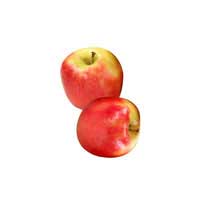 Full List of Fruits
Full List of Fruits  Lady apple fruit
Lady apple fruitLady apple
![]() Introduction of Lady apple fruit
Introduction of Lady apple fruit
Scientific name - Syzygium suborbiculare
Indigenous to open forests and northern Australia plus Papua New Guinea woodland areas, Syzygium suborbiculare commonly known as lady apple or the red apple is a petite underbrush tree, i.e. it grows beneath the forest canopy without penetrating it to any extent. The leaves of the apple are very thick, soft, plus fibrous and are just about 7.2-19 cm long with a broad and oval shape. With more than a few stamens, it bears out flowers that are white in color.
The edible fruits that the tree bears out are flattened-globular, with an uneven spike; they are fleshy with a large seed inside and are 3-7 cm long. The fruits are globular or ovoid in shape and are about 30-70 x 35-90 mm, typically obvious with longitudinal ribbed, calyx lobes that are about 6-13 mm long. Adhering to the rugose facade of the cotyledons by several peg-like incursions, it has a solitary seed that's about 30-55 mm diam, and is testa free from the pericap. Except for the peripheral layer, the other parts of Cotyledons are texture uniformly. During the months of summer, the tree produces white flowers that are delicate and fine; radicle basal or lateral. The fruits of the tree are oval, marble to golf ball sized, coming to the color of the fruits, they are red/pink to white in color and pinkish to red when ripe.
![]() Nutritional Value of Lady apple fruit
Nutritional Value of Lady apple fruit
| Calories from Fat 2 | |
| Calories 72 | |
| % Daily Values* | |
| Total Fat 0.23g | 0% |
| Saturated Fat 0.039g | 0% |
| Polyunsaturated Fat 0.07g | |
| Monounsaturated Fat 0.01g | |
| Cholesterol 0mg | 0% |
| Sodium 1mg | 0% |
| Potassium 148mg | |
| Total Carbohydrate 19.06g | 6% |
| Dietary Fiber 3.3g | 13% |
| Sugars 14.34g | |
| Protein 0.36g | |
| Vitamin A 1% | Vitamin C 8% |
| Calcium 1% | Iron 1% |
With a delicious taste, they are slightly tart, crunchy and succulent. In addition, it provides a great taste all the time. Blushed with encrusted tones of wine-colored and cherry red, it has a thin satin-finished pale lime green skin with too small to see white freckles
Given that, they are rigid to lay a hand on, the fleshy tissue of the fruit is tender, not crunchy. Having said that, Lady Apples are grown far more for their volume and appearance in opposition to their cooking qualities
The fruits are acidic slightly; although not destructive it is good to discard the seeds while eating.
Aboriginal people consumed the fruit raw and it is also believed that the tree was used for medicinal purposes, also as firewood and as a nectar source for bees. The large leaves of the tree are also used on the skin for addressing wounds.
Not only the leaves are used to treat wounds, but the bark along with leaves was also used to make tea which helped in treating diarrhea. Juice extracted from cooked lady apples are used to ease chest congestion and a concoction of trodden leaves was used by Aboriginals to treat diarrhea.


















